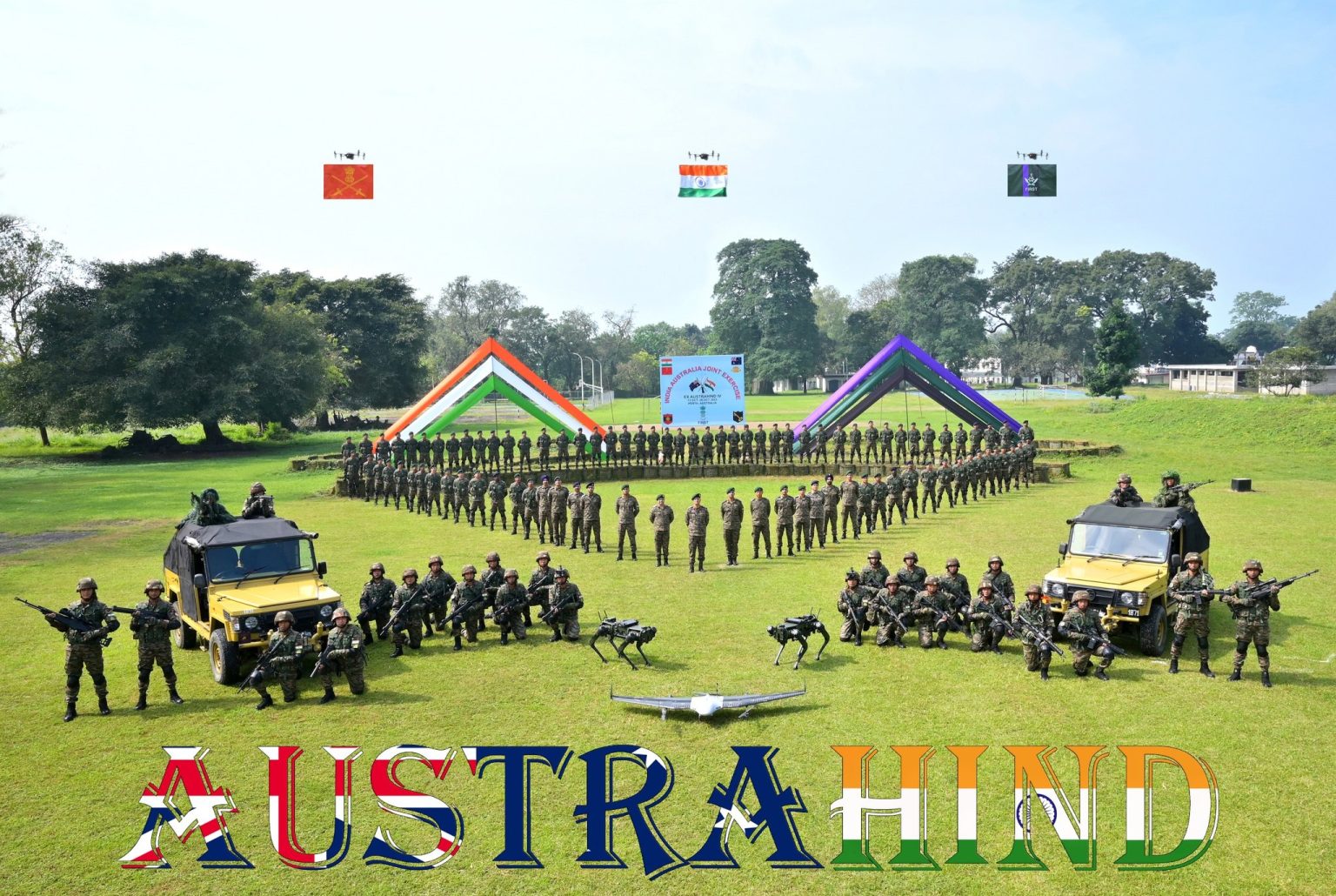Indian Army Troops Arrive in Australia for 4th Edition of Exercise AUSTRAHIND 2025

Indian Army Troops Arrive in Australia for 4th Edition of Exercise AUSTRAHIND 2025
(Source: Indian High Commission, Canberra – October 2025)
Introduction
The 4th edition of Exercise AUSTRAHIND 2025 between the Indian Army and the Australian Army commenced today in Australia, marking another milestone in the growing India–Australia defence partnership. Around 120 troops from the Indian Army have arrived to participate in the exercise, which underscores the shared commitment of both nations to regional security, interoperability, and a rules-based order in the Indo-Pacific region.Organised under the framework of the India–Australia Comprehensive Strategic Partnership, the exercise reinforces the bilateral defence cooperation that has deepened over the past decade, reflecting both nations’ strategic convergence in maritime and continental security domains.
I. Background and Context
The AUSTRAHIND series of joint military exercises were conceptualised to enhance professional military cooperation between the two countries. The first edition was held in 2022 in Rajasthan, India. Since then, the exercise has evolved in scope and complexity, encompassing joint tactical operations, counter-insurgency drills, and specialised combat training.The 2025 edition is being hosted by Australia and focuses on company-level joint operations in open and semi-desert terrain, aimed at improving interoperability, combat readiness, and mission coordination.
II. Objectives of Exercise AUSTRAHIND 2025
- Operational Collaboration:
- To train troops in joint planning and execution of tactical operations in varied terrains under realistic battlefield conditions.
- To strengthen interoperability through combined training on counter-terrorism, area domination, and reconnaissance missions.
- Enhancing Defence Diplomacy:
- To deepen bilateral military engagement and promote trust between the two armed forces.
- To institutionalise defence ties as a critical pillar of the Comprehensive Strategic Partnership signed in 2020.
- Regional and Strategic Significance:
- Reinforces joint commitment to free, open, and inclusive Indo-Pacific principles.
- Supports the broader agenda of Quad security cooperation, which emphasises maritime safety, humanitarian assistance, and disaster relief.
III. Key Features of the 2025 Edition
- Participants: 120 Indian Army personnel and an equal contingent from the Australian Army.
- Focus Areas:
- Joint company-level operations in open and semi-desert terrain.
- Tactical drills including room intervention, combat patrols, and coordinated manoeuvres.
- Exchange of expertise in communication systems, battlefield logistics, and special arms tactics.
- Training Outcome:
- Development of combined standard operating procedures (SOPs) for joint missions.
- Strengthening coordination mechanisms for multinational peacekeeping and regional stability operations.
IV. High-Level Defence Engagements
The exercise follows a series of bilateral defence dialogues and meetings between Indian and Australian leaders:
- Defence Minister Rajnath Singh held productive talks last week with Australian Prime Minister Anthony Albanese and Defence Minister Richard Marles, focusing on expanding defence industry cooperation, joint research in emerging defence technologies, and coordinated maritime operations.
- The discussions reflected mutual emphasis on ensuring a rules-based international order, particularly in the Indo-Pacific, amid growing geopolitical complexities.
V. Strategic and Geopolitical Relevance
- For India:
- Enhances the operational readiness of Indian forces for multi-domain operations in varied geographies.
- Strengthens India’s outreach under its Act East Policy, highlighting its role as a net security provider in the region.
- For Australia:
- Reinforces its engagement with like-minded democracies to safeguard the Indo-Pacific’s maritime and territorial stability.
- Builds tactical and strategic familiarity with one of Asia’s most experienced ground forces.
- For the Indo-Pacific Region:
- Promotes collaborative security mechanisms and deters destabilising influences.
- Contributes to a collective security architecture built on transparency, cooperation, and respect for sovereignty.
VI. Analytical Perspective
Exercise AUSTRAHIND 2025 represents more than a bilateral military drill — it is an expression of strategic alignment and shared geopolitical intent. The evolving nature of the exercise reflects how India and Australia have moved from transactional defence engagement to strategic coordination.Its focus on semi-desert terrain operations indicates preparedness for continental challenges, complementing the existing maritime cooperation frameworks under the Quad and Malabar exercises. The sustained conduct of AUSTRAHIND illustrates how defence diplomacy has become a crucial component of India’s foreign policy in the Indo-Pacific era.
VII. Relevance for UPSC
Prelims Focus:
- Exercise Name: AUSTRAHIND 2025
- Participants: Indian Army and Australian Army
- Location: Australia
- Focus: Joint company-level operations in open and semi-desert terrain
- Objective: Strengthening defence cooperation and interoperability
- First Edition: 2022 (India)
Conclusion
The 4th edition of Exercise AUSTRAHIND 2025 marks a defining step in deepening India–Australia defence cooperation. By enhancing interoperability, fostering mutual trust, and aligning security objectives, the exercise contributes meaningfully to regional peace and stability.In an era of shifting power equations in the Indo-Pacific, such engagements not only strengthen bilateral military capability but also signal a broader convergence among democratic nations committed to a free, open, and rules-based international order.
Updated - October 13, 2025 1:25 PM | News One Air